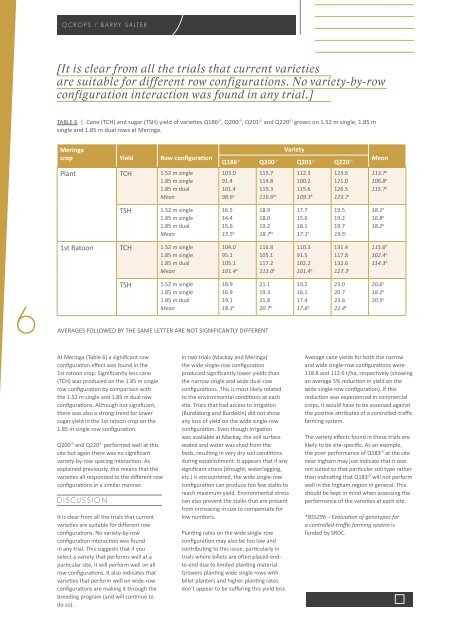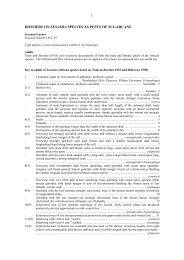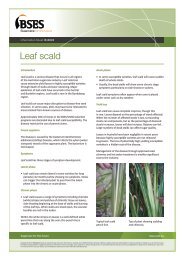You also want an ePaper? Increase the reach of your titles
YUMPU automatically turns print PDFs into web optimized ePapers that Google loves.
6<br />
QCrOps / BArry sALTer<br />
[It is clear from all the trials that current varieties<br />
are suitable for different row configurations. No variety-by-row<br />
configuration interaction was found in any trial.]<br />
TABlE 6 | Cane (TCH) and sugar (TSH) yield of varieties Q186 A , Q200 A , Q201 A and Q220 A grown on 1.52 m single, 1.85 m<br />
single and 1.85 m dual rows at Meringa.<br />
Meringa<br />
crop<br />
AVERAGES fOllOWED BY THE SAME lETTER ARE NOT SIGNIfICANTlY DIffERENT<br />
At Meringa (Table 6) a significant row<br />
configuration effect was found in the<br />
1st ratoon crop. Significantly less cane<br />
(TCH) was produced on the 1.85 m single<br />
row configuration by comparison with<br />
the 1.52 m single and 1.85 m dual row<br />
configurations. Although not significant,<br />
there was also a strong trend for lower<br />
sugar yield in the 1st ratoon crop on the<br />
1.85 m single row configuration.<br />
Q200 A and Q220 A performed well at this<br />
site but again there was no significant<br />
variety-by-row spacing interaction. As<br />
explained previously, this means that the<br />
varieties all responded to the different row<br />
configurations in a similar manner.<br />
DisCussiON<br />
Yield<br />
It is clear from all the trials that current<br />
varieties are suitable for different row<br />
configurations. No variety-by-row<br />
configuration interaction was found<br />
in any trial. This suggests that if you<br />
select a variety that performs well at a<br />
particular site, it will perform well on all<br />
row configurations. It also indicates that<br />
varieties that perform well on wide-row<br />
configurations are making it through the<br />
breeding program (and will continue to<br />
do so).<br />
Row configuration<br />
Plant TCH 1.52 m single<br />
1.85 m single<br />
1.85 m dual<br />
Mean<br />
TSH<br />
1.52 m single<br />
1.85 m single<br />
1.85 m dual<br />
Mean<br />
1st Ratoon TCH 1.52 m single<br />
1.85 m single<br />
1.85 m dual<br />
Mean<br />
TSH<br />
1.52 m single<br />
1.85 m single<br />
1.85 m dual<br />
Mean<br />
Q186A 103.0<br />
91.4<br />
101.4<br />
98.6a 16.5<br />
14.4<br />
15.6<br />
15.5 a<br />
104.0<br />
95.1<br />
105.1<br />
101.4 a<br />
18.9<br />
16.9<br />
19.1<br />
18.3 a<br />
Q200A 115.7<br />
114.8<br />
119.3<br />
116.6bc 18.9<br />
18.0<br />
19.2<br />
18.7 bc<br />
116.8<br />
105.1<br />
117.2<br />
113.0 b<br />
21.1<br />
19.3<br />
21.8<br />
20.7 b<br />
In two trials (Mackay and Meringa)<br />
the wide single-row configuration<br />
produced significantly lower yields than<br />
the narrow single and wide dual-row<br />
configurations. This is most likely related<br />
to the environmental conditions at each<br />
site. Trials that had access to irrigation<br />
(Bundaberg and Burdekin) did not show<br />
any loss of yield on the wide single-row<br />
configuration. Even though irrigation<br />
was available at Mackay, the soil surface<br />
sealed and water was shed from the<br />
beds, resulting in very dry soil conditions<br />
during establishment. It appears that if any<br />
significant stress (drought, waterlogging,<br />
etc.) is encountered, the wide single-row<br />
configuration can produce too few stalks to<br />
reach maximum yield. Environmental stress<br />
can also prevent the stalks that are present<br />
from increasing in size to compensate for<br />
low numbers.<br />
Planting rates on the wide single-row<br />
configuration may also be too low and<br />
contributing to this issue, particularly in<br />
trials where billets are often placed endto-end<br />
due to limited planting material.<br />
Growers planting wide single rows with<br />
billet planters and higher planting rates<br />
don’t appear to be suffering this yield loss.<br />
Variety<br />
Q201A 112.3<br />
100.2<br />
115.6<br />
109.3b 17.7<br />
15.6<br />
18.1<br />
17.1 b<br />
110.3<br />
91.5<br />
102.2<br />
101.4 a<br />
19.2<br />
16.1<br />
17.4<br />
17.6 a<br />
Q220A 123.6<br />
121.0<br />
126.5<br />
123.7c 19.5<br />
19.2<br />
19.7<br />
19.5 c<br />
131.4<br />
117.8<br />
132.6<br />
127.3 c<br />
23.0<br />
20.7<br />
23.6<br />
22.4 b<br />
Mean<br />
113.7 a<br />
106.8 a<br />
115.7 a<br />
18.1 a<br />
16.8 a<br />
18.2 a<br />
115.6 b<br />
102.4 a<br />
114.3 b<br />
20.6 a<br />
18.2 a<br />
20.5 a<br />
Average cane yields for both the narrow<br />
and wide single-row configurations were<br />
118.8 and 112.6 t/ha, respectively (showing<br />
an average 5% reduction in yield on the<br />
wide single-row configuration). If this<br />
reduction was experienced in commercial<br />
crops, it would have to be assessed against<br />
the positive attributes of a controlled-traffic<br />
farming system.<br />
The variety effects found in these trials are<br />
likely to be site-specific. As an example,<br />
the poor performance of Q183 A at the site<br />
near Ingham may just indicate that it was<br />
not suited to that particular soil type rather<br />
than indicating that Q183 A will not perform<br />
well in the Ingham region in general. This<br />
should be kept in mind when assessing the<br />
performance of the varieties at each site.<br />
*BSS296 – Evaluation of genotypes for<br />
a controlled-traffic farming system is<br />
funded by SRDC.




